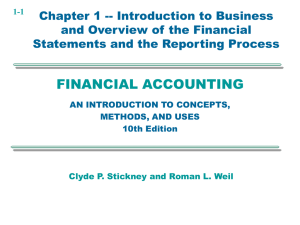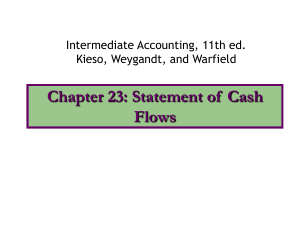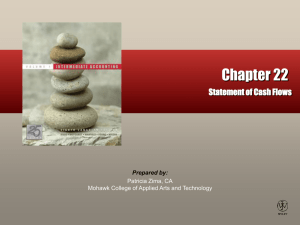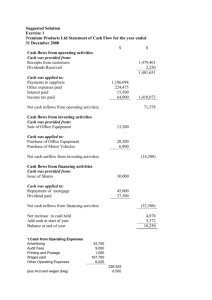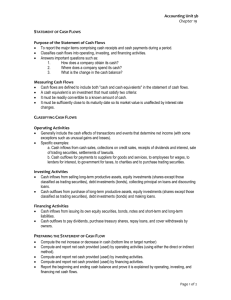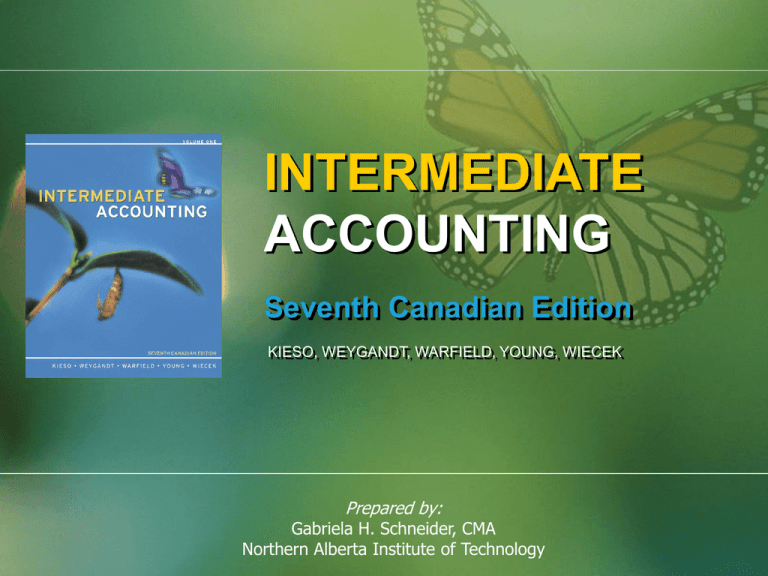
INTERMEDIATE
ACCOUNTING
Seventh Canadian Edition
KIESO, WEYGANDT, WARFIELD, YOUNG, WIECEK
Prepared by:
Gabriela H. Schneider, CMA
Northern Alberta Institute of Technology
CHAPTER
23
Statement of Cash Flows
Learning Objectives
1. Describe the purpose and uses of the statement
of cash flows.
2. Define cash and cash equivalents.
3. Identify the major classifications of cash flows
and explain the significance of each.
4. Contrast the direct and indirect methods of
calculating net cash flow from operating
activities.
Learning Objectives
5. Differentiate between net income and cash flows
from operating activities.
6. Prepare a statement of cash flows.
7. Read and interpret a statement of cash flows.
8. Identify the financial reporting and disclosure
requirements for the statement of cash flows.
9. Use a work sheet to prepare a statement of cash
flows. (Appendix 23A)
Statement of Cash Flows
Introduction to
the Statement
Usefulness
What is cash?
Classification of
cash flows
Format of the
statement
Preparing a
Statement of Cash
Flows
Sources of
information and
steps
First illustration
Second illustration
Third illustration
Interpreting the
statement
Reporting and
Appendix A Disclosure Issues
Use of a
Worksheet
Cash flow
statement
Cash flow per
Preparing the
share
worksheet
Free cash flow
Analysis of
transactions
Financial reporting
examples
Completing
the work
Perspectives
sheet
Usefulness of the
Statement of Cash Flows
•
The information may help users assess the
following:
– The entity’s ability to generate future cash
flows
– The entity’s ability to pay dividends and
meet obligations, and increase capacity
– The reasons why net income and net cash
flow from operating activities differ
Cash and Cash Equivalents
Cash
• Cash on hand
• Demand deposits
All references to Cash
include Cash Equivalents
when discussing the
Statement of Cash Flows
Cash Equivalents
• Investments that are
– Short term,
– Highly liquid, and
– Easily converted to a
known amount of cash
– Subject to an
insignificant risk of
change in value
The Cash Flow Statement
•
The cash flow statement provides
information about:
• the cash receipts (cash inflows), and
• uses of cash (cash outflows) during the
year
•
Inflows and outflows are reported for:
• operating activities
• investing activities, and
• financing activities during the year
Cash Flow Classifications
1. Operating Activities
•
The cash flows resulting from the primary
revenue generating activities of the business,
such as
•
•
•
•
•
Collections from customers
Payments to suppliers
Payments to employees
Payments to CRA for tax
Cash flow provided by operating activities
necessary for long term sustainability of the
business
Cash Flow Classifications
2. Investing Activities
•
•
The acquisition and disposal of long term
assets and long-term investments
Examples include:
•
•
•
Purchase/disposal of capital assets
Acquiring an interest in another corporation
Cash flow generated by investing activities
shows if the business is investing in its future
Cash Flow Classifications
3. Financing Activities
•
•
Changes in long-term debt or equity capital
Examples include:
•
•
•
Issuing debt, or repayment of debt
Issuing new shares, or repurchase of
currently outstanding shares
Provides information to assess potential for
future claims to entity’s cash, extent of debt
and increased interest charges
Exercise E23-1: Identify
Transactions
• Identify each of the transactions as either
–
–
–
–
Operating activity
Investing activity
Financing activity
Significant noncash investing or financing
activity
– None of the above
Exercise E23-1: Identify
Transactions
a) Acquisition of raw materials
Operating Activity (noncash)
b) Declaration of dividends
Financing Activity (noncash)
c) Acquisition of a 4% interest in a company
Investing Activity
d) Contribution to employees’ pension plan
Operating Activity
e) Equipment leased through capital lease
Significant noncash investing and financing activity
f) Office space leased with an operating lease
Operating Activity (noncash)
Exercise E23-1: Identify
Transactions
g)
h)
i)
j)
k)
l)
Paid interest on outstanding debt and amortized the
discount
Financing Activity
Paid the supplier from transaction a)
Operating Activity
Paid for new fleet of vehicles
Investing Activity
Received dividend payment from c)
Operating Activity
Sold vehicles for an amount greater than book value
Investing Activity
Stock options granted to executives
Noncash Operating and Financing Activity
Statement of Cash Flows:
Concept
Operating
activities
Inflows
Investing
activities
Financing
activities
Cash
Pool
Operating
activities
Investing
activities
Outflows
Financing
activities
Significant Noncash
Transactions
• Transactions that do not involve the direct
receipt or disbursement of cash in the period
• Examples:
– Asset purchased, paid for by assuming debt,
or issuance of shares
– Conversion of debt to equity
• Noncash transactions are not reported on the
Statement of Cash Flows
Preparing a
Statement of Cash Flows
• Two methods of preparing the operating cash
flow section of the Statement of Cash Flows:
– Indirect method
– Direct method
• Indirect method derives operating cash flows
from accrual basis income statement
• Direct method determines operating cash flows
directly for each operating source or use of
cash
Cash Flow from Operations:
Indirect Method – Concept
Earned
Revenues
+
Net Income
Expenses
Incurred
-
Eliminate
non-cash revenues
Operating
cash flow
Eliminate
non-cash charges
The Statement of Cash Flows:
Indirect Method
Accrual Basis Statements
Cash Flow Statement
Income Statement items
and changes in Current
Assets and Current Liabilities
Operating activities:
Adjust net income for accruals,
non-cash charges and nonoperating gains/losses
Balance Sheet:
Changes in
Non-Current Assets
Investing activities:
Inflows from sale of assets and
outflows for purchases of assets
Balance Sheet:
Changes in Non-Current
Liabilities and Equity
Financing activities:
Inflows and outflows from loan
and equity transactions
Cash Flows from Operations:
Direct Method
Inflows
• Received from
customers for cash
sales and on account
• Cash dividends and
interest received
Outflows
• To suppliers for cash
purchases and
payments on account
• To employees for
salaries and wages paid
• To government for taxes
paid
• To lenders for interest
paid
• To others for expenses
paid
Format of the Statement of
Cash Flows (Indirect Method)
Cash flows from operating activities:
Net Income (Loss)
Adjustments (List individual adjustments)
Net cash flow from operating activities
$ XXX
$ XX
$ XXX
Cash flows from investing activities:
(List individual inflows and outflows)
Net cash flow from investing activities
$ XX
$ XXX
Cash flows from financing activities:
(List individual inflows and outflows)
Net cash flow from financing activities
$ XX
$ XXX
Change in cash
$ XXX
Format of the Statement of Cash
Flows (Direct Method)
Cash flows from operating activities:
Cash receipts (individually): Inflows
Cash payments (separately): outflows
Net cash flow from operating activities
$ XXX
($ XXX)
$ XXX
Cash flows from investing activities:
(List individual inflows and outflows)
Net cash flow from investing activities
$ XX
$ XXX
Cash flows from financing activities:
(List individual inflows and outflows)
Net cash flow from financing activities
$ XX
$ XXX
Change in cash
$ XXX
Indirect Method: Example
Tax Consultants Inc. began operations on January 1, 2005.
The income statement and balance sheet for year 2005 follow.
Income Statement
Revenues
Less: Operating expenses
Income before Tax
Less: Income Tax
Net Income
$ 125,000
85,000
40,000
6,000
$ 34,000
A dividend of $14,000 was declared during year.
Indirect Method: Example
Balance Sheet
Dec 31, 2005 Jan 1, 2005
Assets:
Cash
Accounts Receivable
Total
$ 49,000
36,000
$ 85,000
$-0-0$-0-
Liabilities and Shareholders’ Equity:
Accounts Payable
$ 5,000
Common Shares
60,000
Retained Earnings
20,000
Total
$85,000
$-0-0-0$-0-
Operating Activities
Accrual Basis
Net Income
$34,000
Accounts Receivable +$ 36,000
Accounts Payable
+$ 5,000
Changes between beginning
and ending balances
Cash Flow
Net Income
$34,000
Less: Increase in A/R
Add: Increase in A/P
$ 36,000
$ 5,000
Operations: Net Inflow $3,000
See explanations next slide
Operating Activities
Accounts Receivable
Increased by $36,000
Cash collections are
less than revenue
recognized
Reduce net income
by $36,000 to derive
cash flows from
operations
Operating Activities
Accounts Payable
Increased by $5,000
Cash paid for purchases
is less than expenses
reported
Increase net income
by $5,000 to derive
cash flows from
Operations; net
income for the year
increases by $5,000
Investing and
Financing Activities
Accrual Basis
Cash Flow
Financing Activities:
Common Stock + $60,000
Retained Earnings +
$20,000
Beg Bal:
$
0
Net Income:
34,000
less: Dividends (14,000)
End Balance: $20,000
Issue of Shares: $60,000
Dividends paid: ( 14,000)
Inflow
46,000
Cash Flow Statement:
(Indirect Method) - Summary
• Cash provided by operating activities: $ 3,000
• Cash used by investing activities:
-0-
• Cash provided by financing activities:
46,000
• Net inflow for the year
$ 49,000
• Beginning cash balance:
$
• Cash, end of year
$ 49,000
-0-
Other Items
• Income statement gains and losses on disposal of
long-term assets must be adjusted in determining
cash from operations. Why?
• These result from investing activities, not
operating activities and
• The amount of the cash flow is the proceeds on
disposal, not the gain or loss
Other Items
• Income statement gains and losses on
redemption of long-term debts must be adjusted
in determining cash from operations. Why?
• These result from financing activities, not
operating activities and
• The amount of the cash flow is the amount paid to
redeem the debt, not the gain or loss
Exercise E23-6: Cash Flows from
Operating Activities - Indirect
Method
• Using the Income Statement and Additional
Information provided
• Prepare the Operating Activities section of the
Statement of Cash Flows
• Year ended December 31, 2005
• Solution follows
Exercise E23-6: Cash Flows
from Operating Activities Indirect Method
Net Income
$1,050,000
Non-Cash Items and
Changes in Working Capital:
Increase in A/R
Decrease in Inventory
$(360,000)
300,000
Increase in Prepaids
(170,000)
Decrease in A/P
(275,000)
Increase in Accrued
10,000
Amortization Expense
60,000
Cash Flow from Operating Activities
(435,000)
$615,000
Direct Method: Concept
Cash Payments
Cash Receipts
To suppliers
Collections from
customers
To employees
less
From receipts
of interest and
dividends
For operating exp
For interest
For taxes
equals
Cash
flow
from
operations
Cash From Operations: Direct
Method
Refer to Tax Consultant Inc. the data for the indirect method.
Cash receipts from customers:
= Revenue from credit sales – Increase in A/R balances
= $125,000 – $36,000 = $89,000
Cash payments to suppliers:
= cost of goods sold
= $85,000 – $5,000 = $80,000
Direct Method:
Operating Activities
Operating Activities:
Cash receipts from customers
Cash paid to suppliers
Cash paid for income taxes
Net cash inflow
$ 89000
(80,000)
(6,000)
$ 3,000
Exercise E23-5: Cash Flows from
Operating Activities - Direct Method
• Using the Income Statement and Additional
Information provided
• Prepare the Operating Activities section of the
Statement of Cash Flows
• Year ended December 31, 2005
• Solution follows
Exercise E23-6: Cash Flows from
Operating Activities - Direct Method
Cash Flow from Operating Activities:
Cash receipts from customers (1)
Cash payments to suppliers
for goods and services (2)
Cash payments to and on behalf
of employees (3)
Cash provided by Operating Activities
$6,540,000
(5,130,000)
(795,000)
$ 615,000
Calculations
(1) 6,900,000 – 360,000 = 6,540,000
(2) 4,700,000 + 450,000 + 700,000
- 300,000 (inv.) + 170,000 (ppd.)
+ 275,000 (A/P) – 60,000 (amort.)
- (280,000 + 525,000) (salaries) = 5,130,000
(3) 280,000 + 525,000 – 10,000 = 795,000
Special Items: Amortization
Given:
Property, plant, and equipment
Accumulated amortization
2005
2004
$277,000 $247,000
(178,000) ( 167,000)
Other information:
Amortization expense
$ 33,000
Gain on sale of equipment
$ 14,500
During 2005, equipment costing $45,000 was sold for cash
Present relevant T- accounts and cash flow information.
Special Items:
Amortization - Steps
• Prepare the T-Account for accumulated
amortization and determine the accumulated
amortization on asset sold
• Determine cash from sale of equipment
• Determine any purchases of plant and
equipment (at cost)
• Identify the inflows and outflows affecting the
operating and investing sections
Special Items: Amortization
1 Accumulated Amortization
2
Equipment Sold
Accum. amort. (beg): $167,000
Plus: amortization
expense
$ 33,000
less: amortization on
equipment sold (?)
$ 22,000
Accum. amort. (ending): $178,000
Equipment sold (cost):
$45,000
Less: Accum. amort. on
equipment
22,000
Book value of equipment sold 23,000
Add: Gain on sale
14,500
Cash from sale of equipment $37,500
3 Prop., Plant, & Equipment
Beginning balance:
$247,000
Add: Purchases (?)
$ 75,000
Less: Equipment Sold $ 45,000
Ending balance:
$277,000
4
Cash Flow Statement
Operating Activities:
Amortization – Adjust. $ 33,000
Gain on sale
($14,500)
Investing Activities:
Sale of equipment - inflow $37,500
Asset purchases - outflow ($75,000)
Reporting Significant
Non-Cash Transactions
•
•
•
•
Transactions not involving cash inflows or
cash outflows are non-cash transactions
They are not reported in the body of the
cash flow statement
If material, they are reported as notes to the
statement or in a supplementary schedule to
the financial statements
Example: issue of bonds (payable) for the
purchase of land
Reporting and Disclosure Issues
CICA Handbook, Section 1540 requires the
following disclosure:
1.
2.
3.
4.
Pre-tax cash flows from extraordinary items
Cash flow for interest and dividend payments
Income tax cash flows
Business combination and business unit/segment
disposal cash flows
5. Policy for determining cash and cash equivalents,
and its components
COPYRIGHT
Copyright © 2005 John Wiley & Sons Canada, Ltd.
All rights reserved. Reproduction or translation of
this work beyond that permitted by Access Copyright
(The Canadian Copyright Licensing Agency) is
unlawful. Requests for further information should be
addressed to the Permissions Department, John
Wiley & Sons Canada, Ltd. The purchaser may make
back-up copies for his or her own use only and not
for distribution or resale. The author and the
publisher assume no responsibility for errors,
omissions, or damages caused by the use of these
programs or from the use of the information
contained herein.



